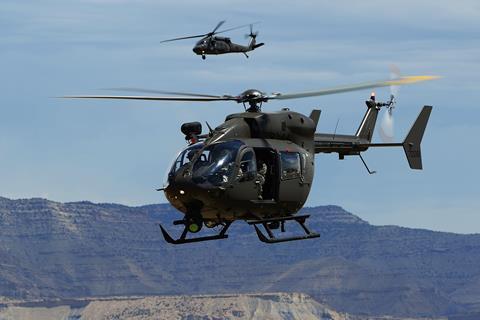The US Army is considering adoption of a new aircraft for initial rotary-wing aviation flight training.
While no alternative has yet been suggested, nor a procurement effort launched, the service is seeking to revamp its Initial Entry Rotary-Wing (IERW) flight training programme, which could include a replacement for the current Airbus Helicopters UH-72A Lakota light trainer.
A special request for information (RFI) contract notice posted by the army on 8 October asks industry vendors in the commercial aviation training space to submit potential training solutions that could help the service “improve the quality of training provided to our new aviators, cut costs and improve efficiency”.

While the effort is primarily focused on services such as contractor-provided academic and flight instruction, “the potential replacement of the current IERW helicopter” is explicitly noted as a possibility.
The UH-72A is a derivative of the H145 civil helicopter. The type, along with the updated UH-72B, is also in service with US Army National Guard to support domestic search and rescue and medical evacuation missions.

The latest UH-72B also boasts a five-bladed main rotor, versus the four-bladed configuration of the earlier UH-72A. The newer Lakota variant also has a distinctive Fenestron shrouded tail rotor, instead of the open tail rotor of its predecessor.
Airbus delivered the first UH-72A to the army in 2006. As of August, the company was supporting an army fleet of 223 Lakota trainers, along with 212 UH-72As and 18 UH-72Bs in the national guard.
The UH-72A has served as the army’s primary training helicopter since 2016, according to Airbus, which says it is actively participating in discussions around plans for the army’s aviation training programme.
“We are, and will continue to be, heavily engaged with the US Army to inform their efforts going forward and provide the best product we can for their training fleet,” Airbus told FlightGlobal on 9 October. “We look forward to continuing our partnership with the army and [to] design an approach that supports the training of future army aviators for years to come.”
Notably, the 8 October RFI says the army is open to either continuing the government-owned/contractor-operated aircraft model or switching to a contractor-owned/contractor-operated solution.
The contractor currently holding the contract for IERW flight training services is Virginia-based Amentum.
Amentum’s website says it has been the army’s rotary-wing training service provider since 1998, claiming to have instructed more than 30,000 students during that time for the US Army, US Air Force and foreign allied services. The company says it currently trains some 1,500 students annually in aviation theory, simulation instruction and live flight training.
However, the army now appears unhappy with that arrangement, saying the IERW programme “currently operates with inefficiencies from years of change and multiple disparate contracts”.
The company did not immediately respond to a request for comment on the matter.
New aviators receive initial flight training at Fort Novosel, Alabama, followed by advanced training on their assigned operational helicopter type, including the Sikorsky UH-60 Black Hawk, Boeing AH-64E Apache or Boeing CH-47 Chinook.
The army is accepting submissions under the IERW RFI until 6 December.































